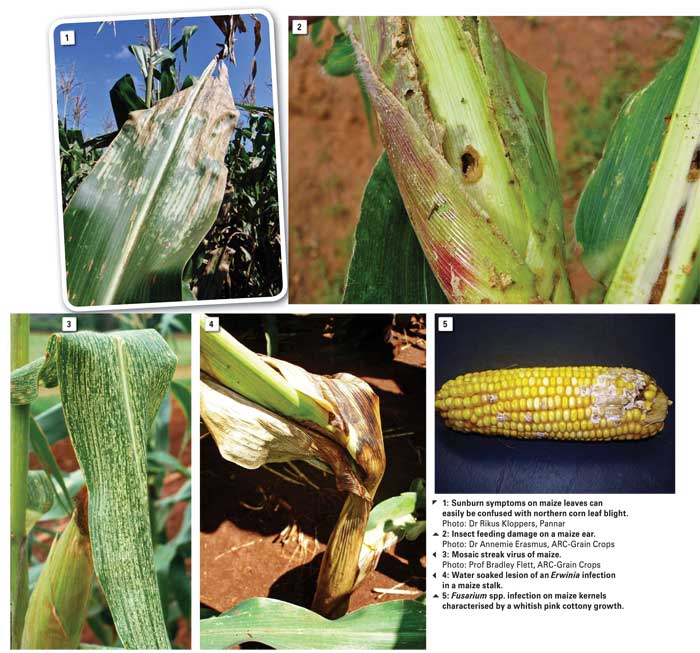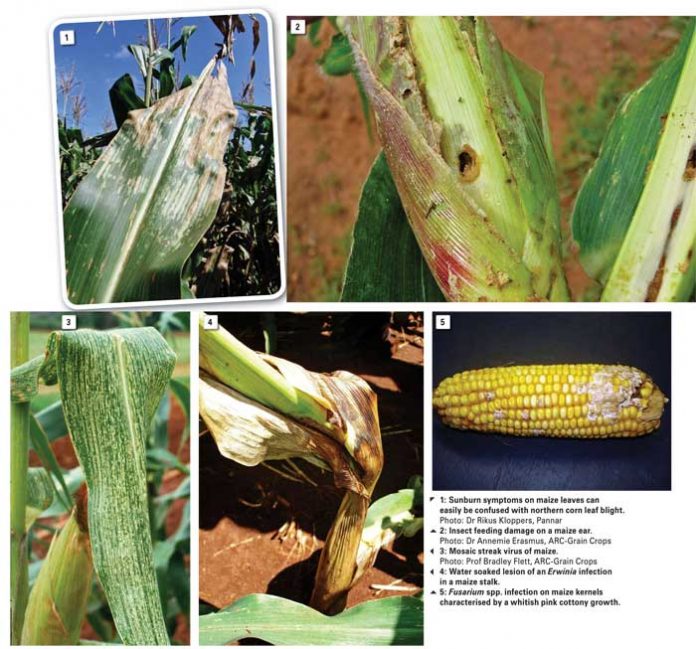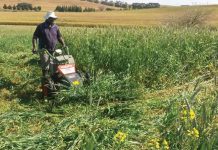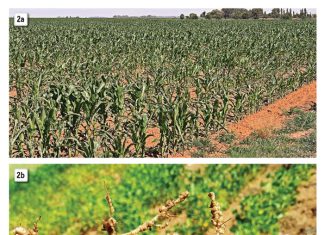September 2017
Drs Adrian Abrahams and Belinda Janse van Rensburg, ARC-Grain Crops, Potchefstroom
Plant health problems usually arise from a variety of abiotic (environmental factors such as cold, heat, salinity, drought) and biotic (plant pathogens causing diseases and insects damaging the plant) stress factors.
Unfortunately, the visual symptoms of these health problems are often similar. Both abiotic and biotic stresses cause major crop damage and result in significant crop losses annually. In order to effectively manage the impact of a certain disease, an accurate disease diagnosis is mandatory so that the impact of the disease can be managed effectively and timeously.
Studies have shown that failure to adequately manage a disease can often be traced back to a failure to correctly diagnose the problem, resulting in wasteful expenditure of chemicals and other control methods.
It is important to note that plants will invariably be affected by biotic and abiotic factors, often in combination. To break the disease cycle, producers must incorporate management strategies that will effectively reduce or control the disease.
In order to incorporate such management practices, accurate plant disease diagnosis plays a crucial role. Often, more than one strategy is necessary for optimal disease management but also, producers should consider any potential economic, environmental and social impacts when implementing such management strategies.
During the development of a disease, three elements are required, namely a pathogen (disease causing virus, bacteria or fungi), a susceptible host (the plant) and favourable environmental conditions for disease development.
The combination of these three elements are called the disease triangle. All three elements of the triangle must be present for the disease to develop. When one of the legs of the disease triangle are unfavourable, the disease cycle can be broken and the disease will not develop.
Abiotic factors
Abiotic disorders are usually caused by temperature, moisture, soil pH, air quality, light regime and nutrition. If any of these factors fluctuate from the optimum range for a given plant species, plant growth might be adversely affected.
Often abiotic factors causing symptoms are diagnosed as a plant disease. For example, sunburn of maize leaves (Photo 1) is often confused with northern corn leaf blight caused by a fungus. Upon misdiagnosis of the ‘disease’, the producer will then be advised to apply a fungicide, which will be ineffective in solving the problem and will cause the producer to incur unnecessary cost.
Abiotic disorders may also be caused by human interference, such as incorrect pesticide and fertiliser applications causing plant tissue to exhibit chlorosis and/or necrosis. A good approach to the sound identification of a plant disease is to start off by deductively eliminating any possible abiotic disorders and insect damage.
Symptoms caused by biotic factors
Insects
Many insects, including caterpillars and beetles, are relatively large and easy to spot. The damage that they cause is often visible as holes in the leaves (Photo 2) or fruit bodies of a plant, a frayed appearance of leaves chewed along leaf margins or deformed leaves.
Additional indications of the presence of insects include frass (dark coloured insect excreta) and sooty mold (a black superficial growth of a fungus on honeydew usually associated with sucking insects).
Viruses
Viral diseases can sometimes be difficult to identify because symptoms caused by viruses vary from plant to plant. The expression of these symptoms can also be affected by the plant’s age and its growing conditions.
An example of a viral disease is mosaic viruses. This virus is mostly spread by sucking insects such as aphids and leafhoppers. Symptoms of this disease include leaves mottled with yellow, white, light and dark green spots or streaks (Photo 3). Occasionally, the leaves are reddish or purplish.
Infected plants grow poorly and may have other deformities or wavy leaves. Leaf margins appear torn because of unequal growth or feel rough because of swollen veins. Unfortunately, there are no control procedures in place for plants already infected by mosaic viruses. Infected plants must be removed and destroyed.
Preventative management practices will include the planting of resistant genotypes and the control of insect vectors with their weed hosts adjacent to fields.
Bacteria
The diagnosis and identification of bacterial diseases are done primarily on the disease symptoms that can be seen in the constant presence of large numbers of bacteria in an affected area.
For instance, Erwinia species usually cause stalk rot, crown rot, stem rot, or fruit collapse. Typical symptoms include water soaked lesions (Photo 4) exhuming a pungent odour. Upon microscopic examination, one will be able to see bacteria oozing out of an infected plant part.
Management practices will include improved sanitation upon handling of the crop and the application of copper-based chemicals. Irrigation schedules can also be changed to the cooler afternoon where possible, because these bacteria multiply rapidly in warm and moist conditions.
Fungi
Fungi obtain their nutrients through absorption of organic matter and are the cause of the majority of plant diseases. They are capable of attacking all plant parts and show symptoms varying from root-, stalk- and ear rots to foliar diseases.
Some fungi cause localised lesions while others spread systematically within the plant. A number of fungi that affect the above ground parts of a plant can be dispersed by air currents, rain or insects that serve as vectors for the fungi.
Symptoms of Fusarium spp. ear rot of maize for example, will vary greatly depending on the plant genotype, environmental conditions and disease severity. Infected kernels are often randomly scattered across the ear or found alongside feeding channels of the stalk borer. Such kernels appear whitish pink to lavender because of the fungal growth on them (Photo 5).
When the disease is severe, the entire ear will appear white and weathered with fungal growth present on and in between kernels. Management practices include the use of fungicides for leaf diseases, sanitation and planting of cultivars with some form of resistance.
Once a disease is correctly diagnosed, a practical and effective disease management programme (often with more than one strategy) may then be recommended. However, with an inaccurate disease diagnosis, these actions will be in vain and will incur extra costs for the producer. To prevent a miss diagnosis, it is strongly recommended to consult with a trained plant pathologist who can identify the disease and recommend appropriate treatments.
For more information contact Drs Adrian Abrahams and Belinda Janse van Rensburg at 018 299 6100.

Publication: September 2017
Section: Focus on


















